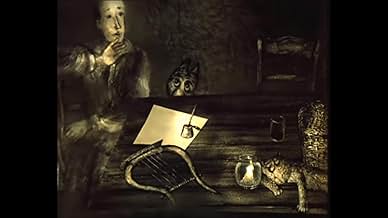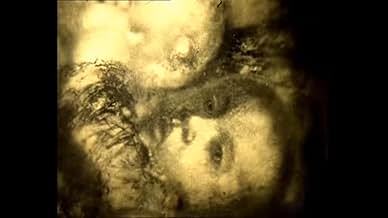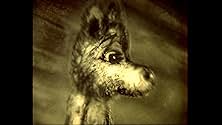VALUTAZIONE IMDb
7,8/10
4379
LA TUA VALUTAZIONE
Aggiungi una trama nella tua linguaDistant, well-worn memories of childhood are inhabited by a little gray wolf. Through astonishing imagery, the memory of all of Russia is depicted.Distant, well-worn memories of childhood are inhabited by a little gray wolf. Through astonishing imagery, the memory of all of Russia is depicted.Distant, well-worn memories of childhood are inhabited by a little gray wolf. Through astonishing imagery, the memory of all of Russia is depicted.
- Regia
- Sceneggiatura
- Star
- Premi
- 2 vittorie totali
Recensioni in evidenza
10kamerad
I must discuss the Russian Yuri Norstein's stunning "Tale of Tales". Like the films of another great Russian filmmaker, Andrei Tarkovsky, this film is about memory and nostalgia. The uses of various techniques of animation, primarily cutouts, not only let us see Norstein's memories, but also help illustrate their dream-like qualities. There are events in this film that, taken literally, could not have happened. However Norstein represents these memories metaphorically, thereby making their emotional impact greater than were he to simply illustrate his memories in a straight forward narrative.
There are a couple of moments that reflect the above-mentioned statement that I feel I must include in this entry. I loved the scene where the little boy is standing in the snow eating an apple , looking up at some crows on a tree branch. The boy then appears on the branch, buddies up with the crows and shares his apple with them. This is a great, moving, but non-sentimental image that lets us feel the child's desire for friendship. Just after that, his father, whose Napoleon hat identifies him as a tyrant, yanks him out of his daydream. The little boy at first struggles, but then a little Napoleon hat appears on his head and he marches in file behind his dad. This scene reminded me of the Disney WWII era short "Education for Death", in that it also is about childhood innocence being destroyed by adults conditioning their behavior. But where "Education." was a didactic propaganda tool, "Tale of Tales" simply shows how sad and unfortunate it is for adults to do that to children, and illustrates it in such a poetic way.
There are a couple of moments that reflect the above-mentioned statement that I feel I must include in this entry. I loved the scene where the little boy is standing in the snow eating an apple , looking up at some crows on a tree branch. The boy then appears on the branch, buddies up with the crows and shares his apple with them. This is a great, moving, but non-sentimental image that lets us feel the child's desire for friendship. Just after that, his father, whose Napoleon hat identifies him as a tyrant, yanks him out of his daydream. The little boy at first struggles, but then a little Napoleon hat appears on his head and he marches in file behind his dad. This scene reminded me of the Disney WWII era short "Education for Death", in that it also is about childhood innocence being destroyed by adults conditioning their behavior. But where "Education." was a didactic propaganda tool, "Tale of Tales" simply shows how sad and unfortunate it is for adults to do that to children, and illustrates it in such a poetic way.
I admit I didn't really "get" this film. There are probably references to things in Russian history and culture that go over my head. But I admire the effort, style and vision that went into this dreamlike fantasy about childhood and war (I think).
This would be the ultimate 3D film experience. I wanted to see this again as preparation for Tarkovsky's "Nostalghia" (1983), which I've long regarded as one of the most amazing films ever made. This, I think, exhibits the same kind of existential meta-melancholy that's somehow deeply rooted in the fabric of the creative process depicted by many of the Russian artists; then, as noted, this has an amazingly perceptive visual eye making it more than a fitting prelude.
It's like entering an infant's dream. Everything is new, nothing is named. What we see is emotion. Color as emotion, motion as emotion, character as emotion. The layered images are stunning, and the eye moves restlessly, zooming in and out on objects and is at times perplexingly active as if it didn't know where it was going, and at times hesitantly passive.
Dreams of a dreamed up being, the maroon light swallowing the thin silhouette-like figures. The minotaur-like figure jumping rope. The wolf, alone in the forest at the fire, taken in by the mysterious light (a sure influence on Polanski and his The Ninth Gate [1999]). This must've been a great influence on Chomet, as well.
This is on par with and in my estimation exceeds "L'Homme qui plantait as arbres" (1988), and a very worthy companion for the best of the Quay Brothers as short animation that reshapes how we see and think, and most importantly, how we dream.
It's like entering an infant's dream. Everything is new, nothing is named. What we see is emotion. Color as emotion, motion as emotion, character as emotion. The layered images are stunning, and the eye moves restlessly, zooming in and out on objects and is at times perplexingly active as if it didn't know where it was going, and at times hesitantly passive.
Dreams of a dreamed up being, the maroon light swallowing the thin silhouette-like figures. The minotaur-like figure jumping rope. The wolf, alone in the forest at the fire, taken in by the mysterious light (a sure influence on Polanski and his The Ninth Gate [1999]). This must've been a great influence on Chomet, as well.
This is on par with and in my estimation exceeds "L'Homme qui plantait as arbres" (1988), and a very worthy companion for the best of the Quay Brothers as short animation that reshapes how we see and think, and most importantly, how we dream.
Great film. The scene of child with birds remind me the almost same scenes form Andrei Tarkovsky's "the Mirror". I see this film on DVD(the collection of Russian Animation films), the effect is marvelous! The total film like a dream, sometimes make you feel bitter, sometimes smile with tears. I like the prelude and fuge by Bach in this film, and the tango music is also used in Nikita Mikhalkov's film " Burnt by the Sun". The Great film(not only the animation film) I have ever seen.
Using a mix of puppet, cutout, and cell animation, Yuri Norstein made in Tale of Tales a heartbreaking, tenderly poetic meditation on Russian history as well as one of the most stunningly beautiful animated films ever. Very hard to get, but don't miss a chance to see this film.
Lo sapevi?
- QuizThe sound of the baby drinking his milk was actually the sound of a puppy, and the sad eyes of the wolf were copied from a magazine picture of a rescued kitten.
- ConnessioniFeatured in Animated Century (2003)
- Colonne sonoreUtomlyonnoe solntse
Written by Jerzy Petersburski
Russian lyrics by Iosif Alvek
Performed by Aleksandr Tsfasman
I più visti
Accedi per valutare e creare un elenco di titoli salvati per ottenere consigli personalizzati
Dettagli
Botteghino
- Lordo in tutto il mondo
- 82.099 USD
Contribuisci a questa pagina
Suggerisci una modifica o aggiungi i contenuti mancanti
















